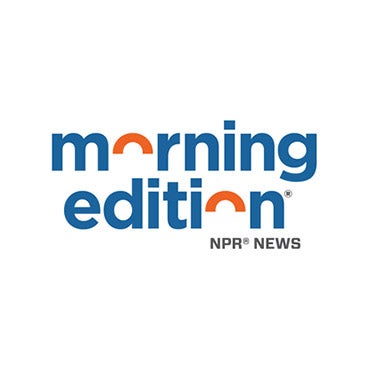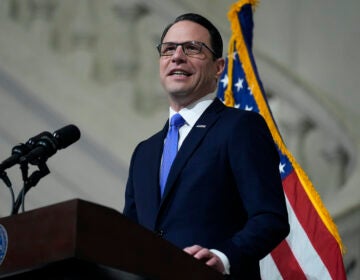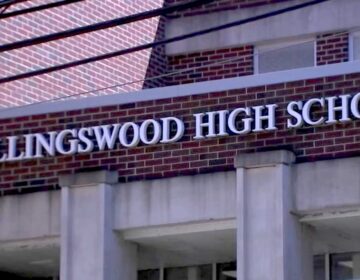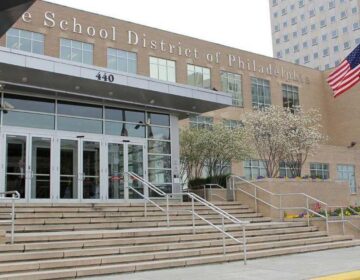How are charter schools funded in Pennsylvania?
Listen
Students arrive on the first day of school in Philadelphia, Pennsylvania. (AP Photo/Matt Rourke)
With education funds scarce in the Commonwealth of Pennsylvania, the debate over how charter schools get their money has never been more polarized. Multiple Choices podcasts explore the history, complexities and controversies of public education funding in Pennsylvania.
Second in an occasional series of podcasts and web “explainers.” To listen to the podcast, click the audio player above.
What makes charter school funding a point of contention?
With education funds scarce in the Commonwealth of Pennsylvania, the debate over how charter schools get their money has never been more polarized.
The stakes are huge: In the 2013-14 school year, 176 charter schools educated 129,000 students statewide, at a cost to Pennsylvania school districts of more than $1.2 billion.
About half those schools and students are located in Philadelphia; they account for 30 percent of the Philadelphia School District’s operating budget.
What are charter schools and how do they get resources?
Charter schools are independently run public schools paid for by tax dollars, authorized and primarily funded by the school districts from which their students come. Districts send charters a per-student payment, based on a state-established formula.
Pennsylvania’s charter school law passed in 1997. Many lawmakers agree that its funding formula is out of date and needs to be revamped, but consensus on how to do that has been hard to achieve.
Charters contend they do not get their fair share compared to districts, because they do not get the same per pupil payments as their home school system.
Districts question some of the payouts going to charters – particularly for special education and cyber charters (online schools where students get home-based instruction).
Mostly, they argue that the state’s system for paying for charters – subtracting from district resources without adding much new state aid to support this separate educational system – is wreaking havoc on their own finances.
How does the formula work?
The formula that allocates money to charters is based on each school district’s per-student expenses for the prior year. So payments vary widely depending on where a student lives.
Each district has a rate for regular education students and one for special education students.
Statewide, for non-special education students, payments range from $6,600 to more than $17,000 per student. Special education amounts are much greater, from $13,000 per child to more than $43,000.
In the state’s formula setting charter funding, certain district expenditures are left out, on the theory that charters don’t incur those costs. These include adult education, mandated district services for nonpublic schools, transportation (districts handle transportation for all students), and facilities construction, including debt service.
Federal aid, which accounts for 13 percent of Philadelphia’s budget, is also excluded, because charters can apply for it in most categories if their students qualify. However, some charter operators say this and some other exclusions are unfair.
The exclusions form the basis of charter school supporters’ contention that charters only get about 70 cents on the dollar compared to what traditional schools get front the state. As a result, this argument goes, they are underfunded while also saving taxpayer dollars.
What is the districts’ complaint with the formula?
District supporters contend that the exclusions reflect the real difference between school district expenses and those for which charters are responsible.
Former Philadelphia District Chief Financial Officer Michael Masch has calculated, for example, that in Philadelphia, average charter per-student expenditures and district per-student expenditures are almost identical, if only operating costs are counted. Some charter supporters dispute his figures.
Masch said in a recent interview that the state charter funding formula is relatively accurate in reflecting district per-student operating expenses. The exceptions, he said, are payments to cyber charters and for special education students. The formula, he said, “is actually written pretty well” and “better than in a lot of other states.”
Charter schools are underfunded, Masch said, because state funding for both charters and school districts is inadequate – not because of the charter funding formula. He called it a “tragedy” that districts and charters are squabbling instead of joining forces to get more state dollars.
Even if charter funding, with some exceptions, accurately reflects charters’ expenditures, Masch said, it still presents districts with a huge financial drain. Each time a student leaves, the district cannot cut its expenses by the amount it must send to the charter; it takes longer to adjust building and personnel expenses to reflect the lower enrollment.
Think of it this way: If two students leave a class with 30 students to transfer to a charter, the class still needs the same teacher paid the same way to serve the remaining 28 students. Any savings on supplies, say, don’t equal the amount of money that needs to be sent.
Here’s another pain point in Philadelphia: About 30 percent of students in charters in the city never attended district schools. They were home-schooled or went to a non-public school. The district needs to pay the charter to educate them just the same way it does for a student who did attend a traditional district school.
Why do charters feel shortchanged?
Many charter supporters say the funding formula shortchanges them. They say that even when some parts of the formula, like special education, favor charters, it just makes up for their being underfunded elsewhere.
David Hardy, founder and head of Boys’ Latin of Philadelphia Charter School, asks, “Why is a charter school kid worth 30 percent less in the state of Pennsylvania? The district says it can’t get by on what it gets, and we receive only 70 to 75 percent of that.”
Hardy is among those who object to excluding school districts’ construction and debt service when calculating charter payments. He said that charters are not included in state reimbursement programs for school construction, and loans they take out are not guaranteed by the state, unlike public school bonds.
“That’s a huge difference between charter school and district funding,” Hardy said. He and other charter advocates say there should be some provision to help charters with construction funding. (Charters are reimbursed for some facility rental costs, if they rent. Some charter construction projects have been financed by county industrial development authority bonds.)
Hardy and Masch agree on one thing.
“There needs to be a bigger pot,” Hardy said. “We should be advocating for more money for all of us.”
But they fundamentally disagree on who is to blame.
Hardy said that school districts undermine prospects for a united front by advocating cuts to charter funding.
“Taking money away from us to make their programs work—that’s not acceptable,” he said.
Masch said charters don’t help when their attitude comes across as: “‘We just want to change the rules so that we get more.’’
In the Multiple Choices podcast, Keystone Crossroads senior education writer Kevin McCorry joins with Paul Socolar, publisher and editor of the Public School Notebook, and Notebook contributing editor Dale Mezzacappa to explain and explore the history, complexities and controversies of public education funding in Pennsylvania.
Look for new installments of Multiple Choices every week for the rest of the spring, as the General Assembly reviews Gov. Wolf’s ambitious school funding and tax plan.
WHYY is your source for fact-based, in-depth journalism and information. As a nonprofit organization, we rely on financial support from readers like you. Please give today.





